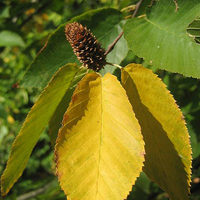Cherry birch (Species at Risk)
Scientific name: Betula lenta

Cover photo credit: Lynk Media
Status
Endangered
“Endangered” means the species lives in the wild in Ontario but is facing imminent extinction or extirpation.
Date added to the Species at Risk in Ontario List
The Cherry birch was already assessed as endangered when the Endangered Species Act took effect in 2008.
What it looks like
The Cherry Birch is a medium-sized deciduous tree that grows up to 20 metres tall. The leaves are oval-shaped with a finely toothed edge and a slender tip.
It is named for its bark, which resembles that of the domestic Sweet Cherry (Prunus avium), a tree that is known to escape from cultivation in southern Ontario.
Unlike other birch trees, this species has smooth bark that is broken into scales without curly or peeling edges. The scales are prominently marked with small lens-shaped blister-like breaks (lenticels). The twigs smell like fresh, sweet wintergreen.
Where it lives
In Ontario, the Cherry Birch is found on moist, well-drained clay loam soil over limestone bedrock with White Oak, Red Oak, Eastern Hemlock, Sugar Maple and other deciduous trees.
Where it’s been found in Ontario
The single population of Cherry Birch in Canada is isolated at two sites on the Niagara peninsula in southern Ontario. A survey of the two sites in 2010, found only 17 trees out of the 50 trees that were originally identified in 1967.
View a Larger version of this map (PDF)
What threatens it
Historically, the main threat to Cherry Birch has been habitat destruction. Development and forest clearing in southern Ontario has caused a decline in suitable habitat for this species.
The remaining population is surrounded by residential development. Moreover, it is exposed to the effects of intense erosion along the shoreline of Lake Ontario.
All mature trees in the population were lost to erosion after severe storms in 2004 and 2005.
Action we are taking
Endangered Species and their general habitat are automatically protected
Recovery strategy
A recovery strategy advises the ministry on ways to ensure healthy numbers of the species return to Ontario.
Read the executive summary (January 11, 2013)
Read the recovery strategy (January 11, 2013)
Government response statement
A government response statement outlines the actions the government intends to take or support to help recover the species.
Read the government response statement (October 11, 2013)
Five-year review of progress
A five-year review of progress made toward protecting and recovering a species is required no later than five years after the government response statement for that species is published.
Read the report on progress towards the protection and recovery of 17 species at risk, including the Cherry Birch (2018).
Habitat protection
General Habitat Protection - June 30, 2013
What you can do
Report a Sighting
- The Ministry of Natural Resources and Forestry tracks species at risk such as the Cherry birch. You can use a handy online form to report your sightings to the Natural Heritage Information Centre. Photographs with specific locations or mapping coordinates are always helpful.
Volunteer
- Volunteer with your local nature club or provincial park to participate in surveys or stewardship work focused on species at risk.
Be a good steward
- Private land owners have a very important role to play in species recovery. If you find Cherry birch on your land, you may be eligible for stewardship programs that support the protection and recovery of species at risk and their habitats.
Report illegal activity
- Report any illegal activity related to plants and wildlife to 1-877-TIPS-MNR (847-7667).
Quick facts
- Early settlers used wintergreen oil from Cherry Birch twigs to treat muscle pain. Aboriginal people have used Cherry Birch bark to make buildings, canoes, storage containers, and for many medicinal applications.
- When Cherry Birch wood is exposed to air it darkens to a colour resembling mahogany and was once used as an inexpensive substitute for this valuable tropical wood.
- Cherry Birch was formerly the main commercial source of wintergreen oil (methyl salicylate), which is distilled from its wood.
- Many flowers contain both female and male reproductive parts, like lilies and roses. However, the Cherry Birch, along with the rest of the birch family, has separate male and female flowers on the same tree. This type of flower arrangement is called “monoecious”.
- Even if there are no other members of its species in the area, the Cherry Birch can still produce fruit. It is able to self-fertilize, which means that female flowers can be pollinated by male flowers on the same tree.
- A Cherry Birch tree can live for 265 years or longer.
